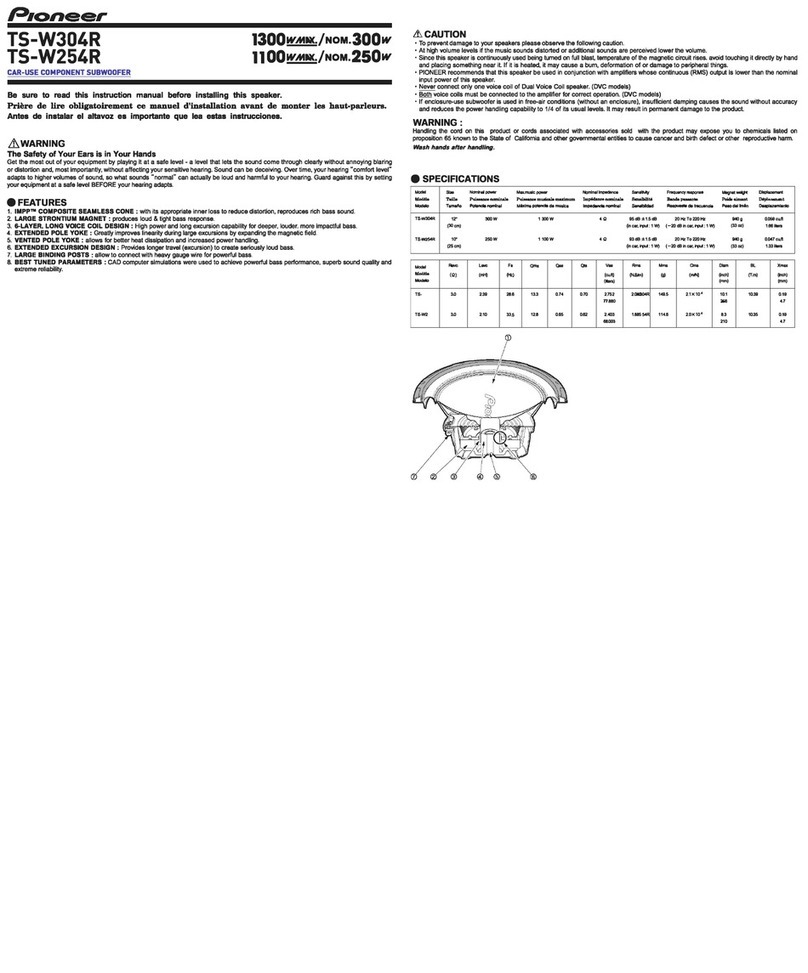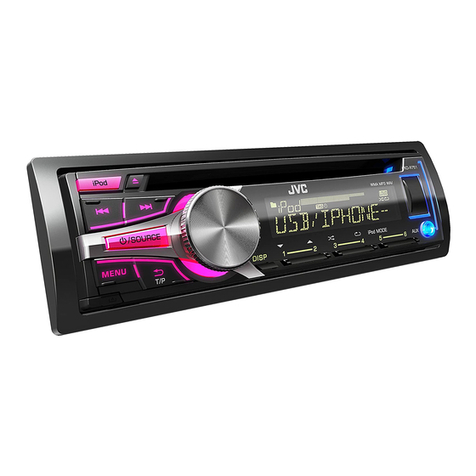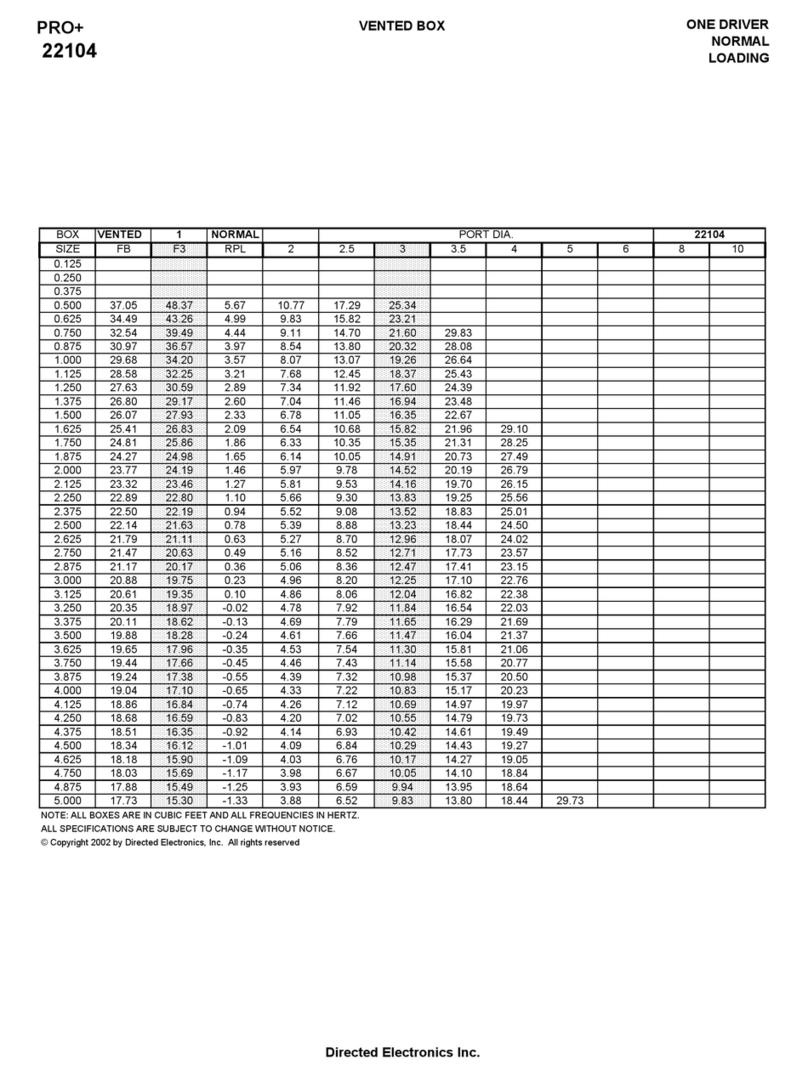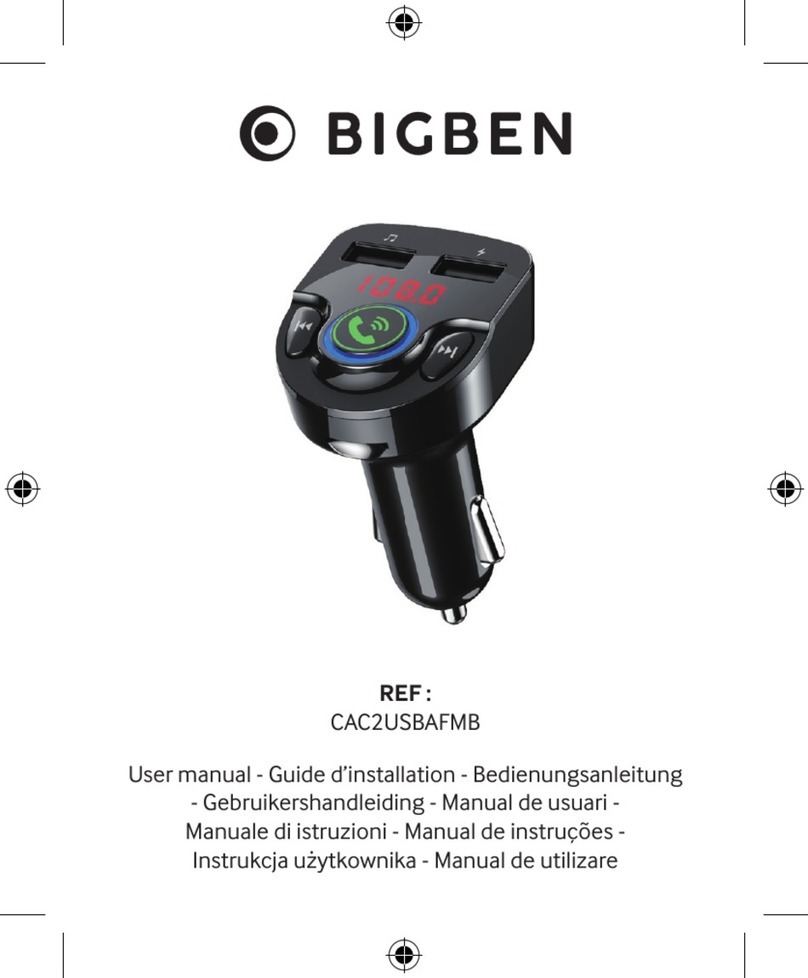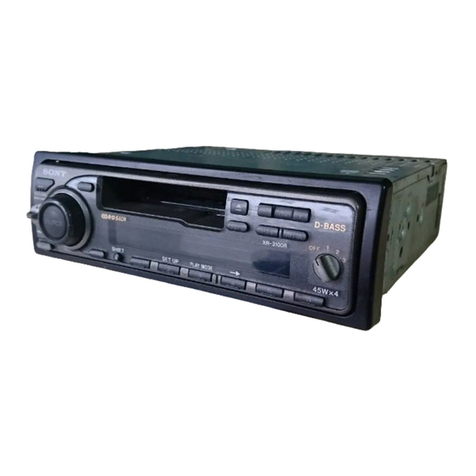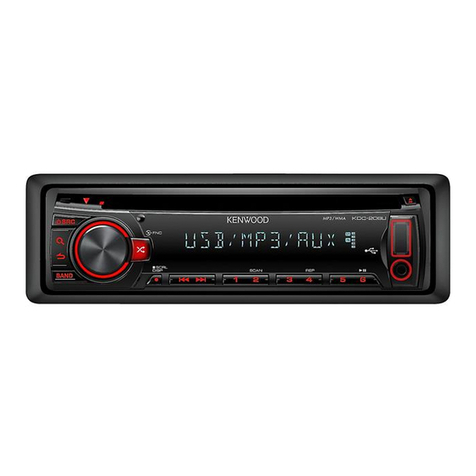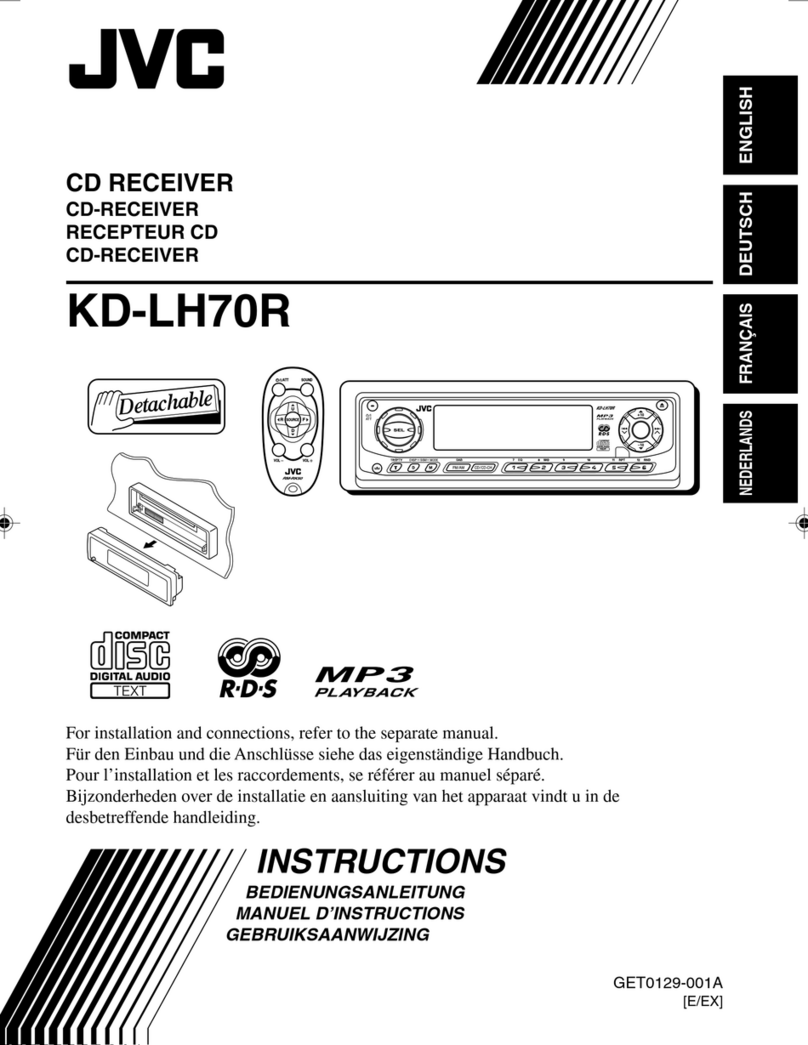Audio Control The Epicenter Micro User manual

FOR COLOSSAL BASS ENHANCEMENT ONLY
Quick Start Guide
Features
• Bass Maximizer circuitry
• Dual Knob Dash Mount Control
• ParaBASS®
• LMC™ Load Selection Input Stage
• Balanced Line Level Inputs
• PFM Subsonic Filter
• Speaker-Level Inputs for OEM integration
• Winter Fresh
• GTO™ Signal Sensing
• Compact Design

2
Quick Start Guide
You now possess the most advanced version of the legendary bass restoration
and enhancement processor. The Epicenter, with over 1 million sold, is the veri-
table master of bass enhancement processing. Silky smooth bass lines will leap
out of your speakers and that kick drum, whether it be the equally legendary
808 or the deep punch that can only come from a 28”kick, The Epicenter Micro
will make every low frequency better.
The Epicenter Micro keeps everything you have come to know and love about
AudioControl’s bass processing and added the OEM integration capabili-
ties that AudioControl leads the world in. Speaker level input stage and the
traditional line level inputs make The Epicenter Micro the go-to product for
any application. Regardless of your age or music preference, the addition of an
enhanced bass response to your mobile audio sound system makes for a truly
amazing experience.
Being that we all vary in our bass response tastes, we’ve added even greater
control over the bass response with the new ACR-4. The Epicenter effect as
well as overall volume control are now part of the dual control ACR-4 control-
ler knob. You can toss out that sub amp volume controller and install just the
ACR-4 knob and have both styles of control at your fingertips!
Supreme ease of control, seamless of OEM integration and installation with
world renown bass restoration, it’s pretty easy to just get going on the install
straight away. Before you start taking apart the car to install this spectacular
processor, please take a moment, grab a Georgetown Brewing Co., Johnny
Utah Pale Ale and read though the details of this manual. The feature list is
long so to take full advantage of everything we’ve packed into this baby, give
this manual a decent read.
Features of the Epicenter Micro
• Bass Maximizer circuitry
• Dash mount control
• Wide and Sweep parametric bass control
• LMC™ speaker level adaptive load input stage
• Multiple turn on options
• ACR-4™ dual controller
• Bass Maximizer effect control
• Overall Sub level control
• PFM Subsonic Filter bypass option
All that means – the best bass enhancement and OEM integration device known
to humanity!
Congratulations!

3
1. Read these instructions.
2. Keep these instructions.
3. Heed all warnings.
4. Follow all instructions.
5. Do not use this apparatus under water.
6. Clean only with a dry cloth.
7. Do not block any ventilation openings. Install in accordance with the
manufacturer’s instructions.
8. Do not install near any heat sources such as mufflers, silencers, exhaust
pipes, or other apparatus (including amplifiers) that produce heat.
9. WARNING: Improper installation may lead to permanent injury or death.
Installation of the apparatus must be done with great care by qualified
personnel, to prevent damage to fuel lines, power, and other electrical
wiring, hydraulic brake lines, and other systems, that might compromise
vehicle safety.
10. Provide +12V and Ground insulated wiring of 14 to 18 AWG to ensure
adequate current to the amplifier.
11. Use rubber grommets to protect wiring whenever passing wires through
metal openings or bulkheads.
12. Only use attachments/accessories specified by the manufacturer.
13. Refer all servicing to qualified service personnel. Servicing is required
when the apparatus has been damaged in any way, such as the power in-
put terminals are damaged, liquid has been spilled or objects have fallen
into the apparatus, the apparatus has been exposed to rain or moisture,
does not operate normally, or has been dropped.
14. Fuses shall be replaced only with the correct type and fuse value, and
only when the apparatus is powered off.
15. Exposure to high sound pressure levels may lead to permanent hearing
loss. Take every precaution to protect your hearing.
The lightning flash with arrowhead symbol within an equilateral
triangle is intended to alert the user to the presence of uninsulated
“dangerous voltage” within the product’s enclosure, that may be of
sufficient magnitude to constitute a risk of electric shock to persons.
The exclamation point within an equilateral triangle is intended to
alert the user of the presence of important operating and mainte-
nance (servicing) instructions in the literature accompanying the
appliance.
Caution: to reduce the risk of electric shock, do
not disassemble the apparatus, other than to
remove the top panel to access the balancing
adjustments on the PCB. There are no user-ser-
viceable parts inside. Refer servicing to qualified
personnel.
Recycling notice: If the time comes and this apparatus has fulfilled
its destiny, do not throw it out into the trash. It has to be carefully
recycled for the good of mankind, by a facility specially equipped
for the safe recycling of electronic apparatii. Please contact your
local or state recycling leaders for assistance in locating a suitable
nearby recycling facility. Or, contact us and we might be able to
repair it for you.
Important Safety Instructions

4
Quick Start Guide
Bass Maximizer – The Epicenter Micro contains a bass maximization circuit
that accurately recreates and injects low frequency information back into
the signal path. What that means in everyday terms is that The Epicenter
Micro will give more bass impact to your best 8-tracks and streaming
services. US Patent #4,698,842
ParaBASS® – What’s the use of having good bass if you can’t control it? The
Epicenter Micro has a unique equalization circuit that contours the
restored bass to your speaker system.
ACR-4 Dual Dash Mount Control – The Epicenter Micro is designed to be
mounted anywhere in the vehicle, with the exception of the front
bumper or radiator. The new ACR-4 and a healthy run of cable is included
for remote level control. This fine streamlined ACR-4 dual controller offers
control over the Bass Maximizer effect (outer knob) and the overall sub
level or volume (inner knob). Every tune’s mix is a little different and this
controller dials your sub’s performance like nothing else on the planet.
Sublime accuracy for your heightened enjoyment!
PFM Subsonic Filter – This unique feature is legendary with many
AudioControl fanatics for its ability to fine tune the bass response of any
system. With The Epicenter Micro, we’ve adjusted the performance down
to 20 Hz and have added the Bypass switch on the top cover for those
of you who want to hit some rich unknown low tones. Best be careful
with that Bypass switch though; engage at the risk to your precious subs.
Running full tilt on this baby can easily launch your sub right out of the
basket, so the word here is“careful please”.
Bass Output Control – The Epicenter circuitry has the ability to produce large
amounts of deep, mind shattering bass without damaging your speakers.
The Bass Output Control circuit manages the voltage generated by The
Epicenter Micro to maximize the bass output of any autosound audio
system while restraining destructive bursts.
Features

5
The AudioControl Epicenter Micro was designed
to produce bass like you have never heard before.
With that said it is important to take the following
precautions during its use.
1. If you have an equalizer in your system, turn down
the bass frequencies to zero boost.
2. You will want to reduce any other bass tone
control, loudness control, or other secondary bass
controls prior to turning on The Epicenter Micro.
Once your system is up and running, you may
want to use those secondary controls to dial the
bass in a bit more but we doubt it!
3. Good bass response requires an appropriate
choice of speakers and amplification. Since the
bass frequencies always require more power
and cone area than higher frequencies... BE
PREPARED. Small speakers and lack of power will
be detrimental to your system.
The Epicenter Micro needs to be installed in the signal path between a source
and an external amplifier(s). Although it can be installed after an equalizer, it
was designed to be installed before a crossover and other signal processors for
optimal performance.
Once this is done, you just need to hook up power, ground, trigger, run the
wire to the dash remote and tada!!! Instant bass. If you need to know more,
then read on. Even if you don’t think you need to know more, you should still
read on, because you can never know too much.
Quick Start

6
Quick Start Guide
The Guided Tour
1. Inputs – The input stage of The Epicenter Micro gives you options! If you
have line level inputs, then just hook up those RCAs and you’re all set. If
you’re integrating into a factory system, you have the speaker level inputs
available as well.
2. Bass Level Control – As we hinted at above in prior luminescent prose
that you’ve had the pleasure of reading, the Bass Level Control is done
with the ACR-4 remote. The ACR-4 is the remote level controller that was in
the same box as this Epicenter Micro and amazingly enough, we included
a pretty long cable for you to run through your car for installing it in the
just right position! So plug it in and turn it up!
3. LMC Load Select – The Epicenter Micro’s default 20 kΩ input setting is
designed to present NO load to the output of the factory amp, which
can make some factory amps upset and stop passing audio. The lower
impedance options of the Load Selection feature tricks the factory amp
into detecting a speaker load so it will continue to pass audio.
20 Ω – Best suited for late model Dodge/Chrysler/Jeep/Ram/Fiat
vehicles equipped with OEM base sound system. (no separate factory
amplifier)
60 Ω – Best suited for late model Dodge/Chrysler/Jeep/Ram/Fiat
vehicles equipped with a separately amplified OEM“premium” sound
system.
20 kΩ – Best suited for all other applications.
qw
e tyr u i
o
1)
1!
1@
J4
J2
BAL
UNBAL R
L

7
4. Internal Balance Jumpers – The default setting here is the ideal configu-
ration. However, just like Pale Ales, there’s a lot of variation from car to car
and install to install. On the rare occasion you have noise that the Ground
Isolation option didn’t resolve, you can remove the top two screws on each
side panel and remove the lid and change these jumpers from Balanced to
Unbalanced or some combo thereof.
5. Trigger mode – Having options for getting turned on is always a nice
thing. Accordingly, the Trigger Mode switch provides you with three ways
to set up your turn on mode for The Epicenter Micro:
Remote in – When set to this turn on mode, The Epicenter Micro will only
turn on when 12 volts DC is applied to the Rmt (remote) jack
GTO – the Great Turn On™ setting will turn The Epicenter Micro on when
the factory system is on. This circuit senses when the factory amp stage is
active. Super convenient!
Audio – Setting the Trigger Mode to Audio will turn on The Epicenter
Micro when actual audio signal is sensed at the input stage – either at the
speaker level or line level inputs.
6. Ground Isolation – On the rare occasion that you can hear the brakes or
blinkers or the windshield wipers through your stereo, then you should
start here first for some easy troubleshooting. Switching this option around
should get rid of noise issues in typical set ups. The default position at the
ISO position is for the best but your mileage may vary.
7. PFM – As we’ve noted before, best be careful with this one. Leaving it to ON
and proper gain staging will ensure your subs will live a long life. Bypassing
the PFM may shorten the life of your fine sub depending on it’s frequency
handling capabilities. The PFM filters the lowest frequencies below 20Hz
which you can’t hear anyway, but if these ultra-low frequencies are present
and run through the electron garden of bass enhancement that is The
Epicenter Micro, you can do some serious damage to a sub. So, careful.
8. Output Voltage – This setting maximizes the bass performance of the
signal while making sure it doesn’t exceed some nominal voltage output.
The Epicenter Micro will make prodigious bass from the thinnest of signals
so you’ll want to make sure the downstream signal processor or amp can
handle the voltages that this puppy can offer. Check the specs & do some
reading - if that downstream device isn’t an AudioControl processor or
amp, it may not have the best performance with that immense sub signal
voltage that The Epicenter Micro will produce.
9. Power Terminal Block – You’ll hook up your power, ground, and trigger in
and outs here:
Ground – You’re a pro, have great style, you know what you’re doing
with wiring up grounds and know that a good grounding scheme means
unwanted noises. Running your ground wire directly to the negative
on the battery is best but attaching to the chassis where there is good
ground path is perfectly sufficient as well.
+12V – Connect your +12V to a constant to the positive battery terminal.
RMT IN – This is for a 12V trigger source or a switched 12V from a head unit.
RMT OUT – Run this to your amp’s 12V trigger or remote input.
10. ParaBASS® – The ParaBASS controls allow you to shape The Epicenter bass
restoration effect to your specific application and vehicle acoustics. The
Sweep control allows you to select a center frequency (the frequency most
affected) between 27 and 63 Hz. The Wide control allows you to control
the shape of the filter centered around the Sweep frequency.
11. Bass Maximizer LED – This little yellow LED dances when The Epicenter
Micro is doing its job - maximizing bass. How much or how little the LED
dances depends on input level from the source. Adjustments to the Bass
Maximizer effect from the ACR-4 (outer knob) will have no affect on this LED.
12. Output – Connect these RCAs to your amp and turn it up!
Guided Tour continued

8
Quick Start Guide
Bass Maximization Technology – Maybe more than once in a lifetime,
you may ask yourself, “Why would I need to restore bass?”The truth
is that during the recording process and in the compression process
as well as through the various streaming algorithms, low frequency
information can be“mixed”down or filtered out. It’s not that record-
ing engineers are out to get you; in fact they are looking out for
your best interests and are concerned that many speaker systems
cannot handle “truly” low bass information.
The patented circuit inside The Epicenter Micro is designed to
reproduce the low frequency information by looking at the upper
frequency ranges and detecting musical harmonics. These harmon-
ics then allow The Epicenter Micro to drop down a few octaves and
reproduce the“missing” bass notes.
The bottom line is that The Epicenter technology gives you deep,
prodigious, body shuddering, heart stopping bass.
Pro Tip: Looking at this graph above, you can see that the Epicenter looks at the
higher frequencies to create the effect and ramps up the effect as it moves
down the frequency spectrum. When a Low Pass only signal is used, the
Epicenter doesn’t get that much signal to work with and loses some of the
impact that we designed it to have.
30Hz 60Hz 90Hz 120Hz 150Hz 180Hz
Fundamental
(First Harmonic)
Second
Harmonic
Third
Harmonic
Fourth
Harmonic
Studio / Compression Rolloff
The Story Behind The Epicenter Micro

9
So now that you have all the detailed operational bits down pat and you’re
halfway through that Johnny Utah, time to get going on the install details.
Like we said before, you’re a pro and have the skills to install this bad boy right
now. But let’s review together those details to ensure you only have to do this
once.
Placement – The Epicenter needs to be installed in the signal path after the
source and BEFORE any crossover circuit. You can have it before or after
an EQ but we recommend before so if you need to, you can contour the
sound a bit with those controls. Definitely install before the crossover as
that will get you the optimal performance from The Epicenter Micro.
Mounting – Once you have selected a permanent mounting location, position
the unit and mark the appropriate mounting holes with a felt-tip pen or
scratch awl. Before doing anything else, make sure you are not about to
drill a hole in a gas tank or pierce any existing wiring. Nothing ruins your
day more than an expensive repair bill. Drill a small pilot hole and secure
the chassis of The Epicenter Micro with self tapping screws
WARNING: Failure to disconnect the negative terminal of your battery prior to the
installation of The Epicenter Micro can result in a warm tingly feeling.
(Pro Tip: You can remove this Power Terminal connector while wiring up)
Ground Connection – Use an 18 gauge wire or larger and run it from the
“Ground”connector on The Epicenter Micro to the negative terminal
of the battery, a ground bus, or a verified ground location. The factory
head unit ground location was designed for the factory system, not your
awesome aftermarket additions so don’t use that location! When the
electrical connections are complete, you may reconnect the negative
terminal to your battery.
Positive(+12V) Connection – Use an 18 gauge or larger wire and run it from
the “+12V” connector of your Epicenter. Connect it to a good constant
source of 12 volts (we suggest the battery), fused at 1 amp.
Remote In – Labeled “Rmt In.” Connect a 22 to 18 gauge wire from the head-
unit’s remote turn-on or other switch 12v source to the “Remote In”
connector on The Epicenter.
Remote Out – Labeled “Rmt Out.” Connect 22 to 18 gauge wire from this jack
to the Remote or 12V trigger input on your amp
Installation Power Connections

10
Quick Start Guide
Placement and Mounting – The dash control may be mounted under the
dash using its own bracket or through a custom hole in the dash. It
should be within reach of the driver and in a spot where the LED is
plainly visible.
Dash Bracket Installation – The dash control mounts with four screws which
attach to the underside of the dashboard. Slide under the dash and place
the dash control in its mounting position, mark the four mounting holes,
drill pilot holes, and secure with four screws.
Custom Installation – For that custom, finished look, the dash control can be
flush mounted directly on the dash board (or anywhere else).
Start by removing the two knob set screws and removing the knobs.
Remove the two screws securing the enclosure to the bracket and
remove the enclosure. Loosen and remove the nut and washer securing
the potentiometer to the bracket. Remove the circuit board assembly
(potentiometer, LED, phone jack) from the bracket.
Drill a 9/32” hole in the dashboard for the potentiometer along with a
1/8” hole for the lock tab, and a 1/8”hole for the LED. Reassemble the
dash control components on the dashboard.
All the bits broken out for you!
ACR- 4 Dash Control Installation
Installation continued

11
The bass response in a system is affected by four factors; (1) the acoustics
of the vehicle, (2) the location of the speakers, (3) the music or podcast
from the source unit, and (4) speakers and speaker enclosures. Because of
variations in the recording process, streaming algorithms and compression
technologies, we developed The Epicenter circuit to help restore any low
frequencies lost during capturing and playback. However, the acoustics
of various environments play a most prominent role in what you experi-
ence when you play back the“tape”. With this in mind, our coffee-laden
engineers developed the unique ParaBASS® system. Use these fantastic
quasi-parametric parameters to tune in to your favorite broadcast of the
Hits from Ganymede™ & dial in that bass response when those broadcasts
are unavailable.
Adjusting the ParaBASS Controls
10 20 30 50 100 200 300 500 1K
CCW = 27 HZ CENTER FREQ.
DET = 45 HZ CENTER FREQ.
CW = 63 HZ CENTER FREQ.
10 20 30 50 100
CCW
DET
CW
200 300 500 1K
CENTER FREQ.
The Sweep control allows you to select a center frequency (the frequency most
affected) between 27 and 63 Hz.
The Wide control allows you to control the shape of the filter centered around
the Sweep frequency.
Installation continued

12
Quick Start Guide
Bass Output Control – The Epicenter is the most powerful bass component
in the history of autosound. Able to shake tall buildings with a single
note and all that kind of stuff. With that in mind we have equipped The
Epicenter Micro with several different Voltage Output settings that limit
the max voltage output so it doesn’t overwhelm your amp or create
unwanted distortion. If you should need to change the settings, please
use the chart below for guidance. A word of advice: listen to the factory
setting before changing your Bass Output settings.
PFM Subsonic Filter – Many car audio systems truly push the limits of their
subwoofer... without really knowing it. Tuned and or ported enclosures
affect the roll-off of many speakers, yet lots of source material forces the
speakers to play lower than expected. The net result is wasted amplifier
power and damaged speakers. The AudioControl PFM filter is a subsonic
filter set to 20Hz. It allows you to only let the speaker play as low as it
should be playing. Because every system is different, your downstream
devices like a DSP, analog EQ or amps may have some processing on
those ultra low frequencies such that you don’t want The Epicenter Micro
to filter, we are giving you the option to Bypass this filter. Save yourself
a little anguish and look up some info on reproducing frequencies 20Hz
and below. Best to be sure about selecting Bypass before engaging this
switch. In most any case, the 20 Hz filter will give you the best response
but if you need something lower, like a good neighbor, the Bypass switch
is there for you.
Installation continued
Setting Output & Subsonic Filter Controls
Recommended Settings
Setting Amplifier Input Voltage Rating Minimum Speaker Size
5 Volt 5 Volts or less 8”
7.5 Volt 7.5 Volts or less 10” - 12”
10 Volt Do they make those? 12” - 32”

13
45 150
10070 85
ACR-1
LC-1.800
High Power Mono Subwoofer Amplifier
2 Ohm Stable, Active Speaker Level Inputs,
AccuBASS®Bass Restoration,
MILCTM Source Clip Detection, GTOTM Signal Sense,
24 dB / Octave Linkwitz-Riley Crossover,
and Remote Level Control
Aftermarket head unit
Subwoofer
+
System #1: Bass Enhancement for Aftermarket Systems
System Examples

14
Quick Start Guide
Subwoofer
+
45 150
10070 85
ACR-1
LC-1.800
High Power Mono Subwoofer Amplifier
2 Ohm Stable, Active Speaker Level Inputs,
AccuBASS®Bass Restoration,
MILCTM Source Clip Detection, GTOTM Signal Sense,
24 dB / Octave Linkwitz-Riley Crossover,
and Remote Level Control
Factory head unit
System #2: Bass Enhancement for Factory Systems
System Examples continued

15
Front Speakers
Rear Speakers
Subwoofer
Front High Speaker Level
Front Low
Speaker Level
Rear Full Range Speaker Level
Factory Head Unit
Front
Rear
Sub
Front
Rear
Sub
System #3: Bass Enhancement for Sound Quality Systems
System Examples continued

16
Quick Start Guide
No Power – If the LED on your dash remote is not on, check the“Power” light
on the chassis of The Epicenter Micro. If the “Power” light is on, you will
want to check to make sure that the cable connecting the remote to the
chassis is not pinched or disconnected. If the “Power” light is off check to
make sure that the power wire and remote turn on wires are connected
or a fuse has not blown.
No Restoration – When your system is playing and yet you don’t hear any
difference in the sound, try turning the outer knob clockwise. If you still
don’t hear any effect, then you need to make sure that you have The
Epicenter Micro in the right part of the signal chain. It must be installed
BEFORE any crossovers in the system. Note: If you are using a source unit
with a built in crossover or processor, you must run a full range output to
The Epicenter Micro’s inputs. Also, check that the ACR-4 cable is plugged
in all the way.
Sounds Distorted – Should your system sound distorted or your speakers
are moving way too much, you should decrease the amount of bass
restoration by turning the either knob or both knobs control knob count-
er-clockwise. If you’ve Bypassed the PFM, probably should re-engage it
or lower the setting on your Voltage Output control.
Still Distorted – Adjust the Para Bass controls by turning the sweep control
clockwise to raise the center frequency. If you still have distortion, you
should power down The Epicenter Micro, change the Voltage Output
setting to a lower position (i.e. 5 volts).
Troubleshooting

17
4. You cannot let anybody who isn’t: (A) the AudioControl factory; (B)
somebody authorized in writing by AudioControl to service The Epicenter
Micro. If anyone other than (A) or (B) messes with The Epicenter Micro,
that voids your warranty.
5. The warranty is also void if the serial number is altered or removed, or if
The Epicenter Micro has been used improperly. Now that sounds like a big
loophole, but here is all we mean by it.
Unwarranted abuse is: (A) physical damage (don’t use The Epicenter Micro
for a car jack - far too small!); (B) improper connections (120 volts into the
power jack can fry the poor thing); (C) unreasonable use cases (like hot
rodding your oven to pump out low frequency heat waves). This is the
best mobile audio product we know how to build, but if you mount it to
the front bumper of your car, something will go wrong.
6. The warranty is five years from the date of purchase.
Assuming you conform to 1 through 6, and it really isn’t all that hard to do, we
get the option of fixing your old unit or replacing it with a new one.
People are scared of warranties. Lots of fine print, months of waiting around.
Well fear no more, this warranty is designed to make you rave about us to
your friends. It’s a warranty that looks out for you and helps you resist the
temptation to have your friend,“...who’s good with electronics”, try to repair
your AudioControl product. So go ahead, read this warranty, then take a few
days to enjoy The Epicenter Micro before sending in the warranty card and
comments.
“Conditional”doesn’t mean anything ominous. The Federal Trade Commission
tells all manufacturers to use the term to indicate that certain conditions have
to be met before they’ll honor the warranty. If you meet all of the conditions,
we will warrant all materials and workmanship on The Epicenter Micro for one
year from the date you bought it (five years if it is installed by an authorized
United States AudioControl dealer). We will fix or replace it, at our option,
during that time.
Here are the conditional conditions:
1. You have to fill out the product registration over at our website www.
audiocontrol.com and send it to us within 15 days after purchasing The
Epicenter Micro.
2. You must keep your sales receipt for proof of purchase showing when and
from whom the unit was bought. We’re not the only ones who require
this, so it’s a good habit to be in with any major purchase.
3. The Epicenter Micro must have originally been purchased from an autho-
rized AudioControl dealer. You do not have to be the original owner, but
you do need a copy of the original sales slip.
The Warranty

18
Quick Start Guide PN 915-028-0 Rev C
Specifications
All specifications are measured at 14.4 VDC (standard automotive voltage). As technology advances, AudioControl reserves the right to continuously change our specifica-
tions, like our Pacific Northwest weather, although we are working on a surround-sound umbrella as well.
The Epicenter Micro
Inputs
Maximum Input Line Level (RCA) ..................................15Vrms
Maximum Input Speaker Level ..................40V/400W (20K Ω setting)
Input Impedance Line Level ...........................................7kΩ
Input Impedance Speaker Level ................Selectable 20Ω, 60Ω, 20kΩ
Outputs
Preamp Outputs ....................................................1 pair
Max Output Level ................................................13V Peak
Output Impedance .................................................150Ω
Performance
THD. . . . . . . . . . . . . . . . . . . . . . . . . . . . . . . . . . . . . . . . . . . . . . . . . . . . . . . . . . . . . . . . .0.03%
Frequency Response ...............................10Hz to 22kHz, +/- 1dB
Signal to Noise Ratio ..............................................>105dB
PFM Filter ..................................................Bypass or 20Hz
General
Power Supply .............................High Headroom PWM Switching
Current Draw...................................................... 300mA
Recommended Fuse ...................................................1A
Weight. . . . . . . . . . . . . . . . . . . . . . . . . . . . . . . . . . . . . . . . . . . . . . . . . . . . . . . . . . . . . 0.6 lbs
Dimensions ...........................................5.12”W x 3” D x 1”H
©2021 AudioControl. All rights reserved.
All specifications are subject to being covered in hot sauce without notice.
AudioControl, Inc.
22410 70th Avenue West
Mountlake Terrace, WA 98043 USA
Phone: 425-775-8461
email: sound.great@audiocontrol.com
For more information about this fine product, and for details of the limited
warranty and repair services, please visit www.audiocontrol.com
Table of contents
Other Audio Control Car Stereo System manuals
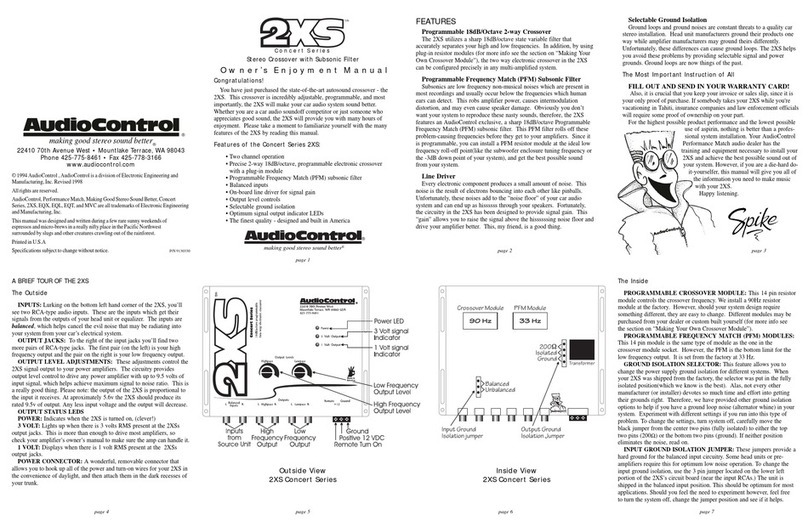
Audio Control
Audio Control 2XS User manual
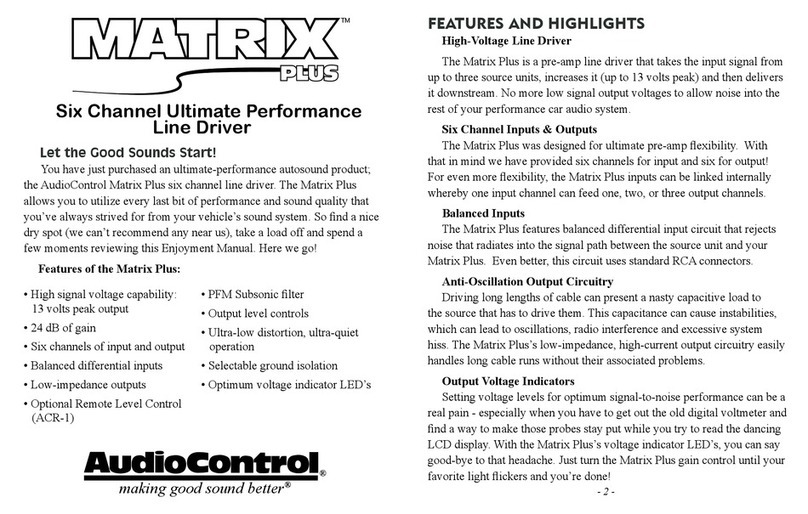
Audio Control
Audio Control Matrix Plus User manual
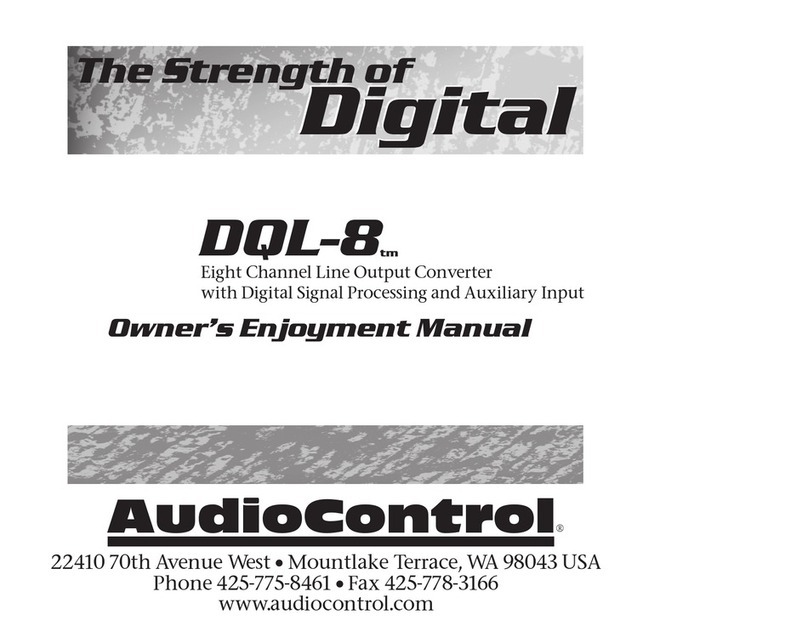
Audio Control
Audio Control DQL-8 User manual

Audio Control
Audio Control EX concert series User manual
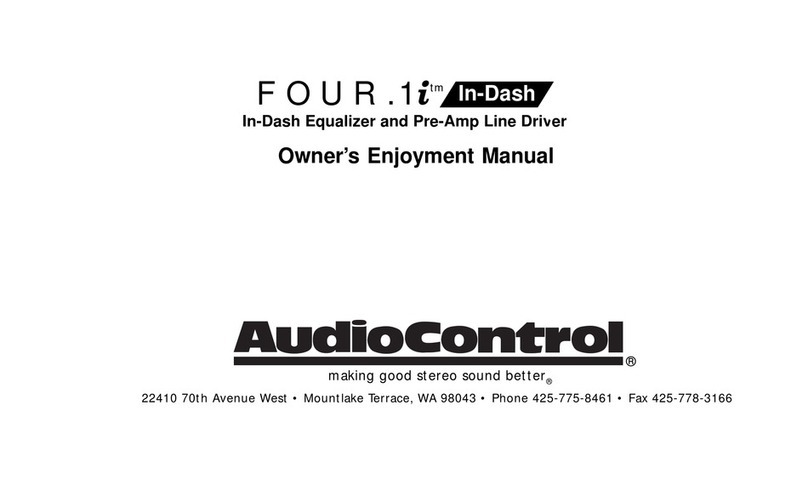
Audio Control
Audio Control FOUR.1i User manual
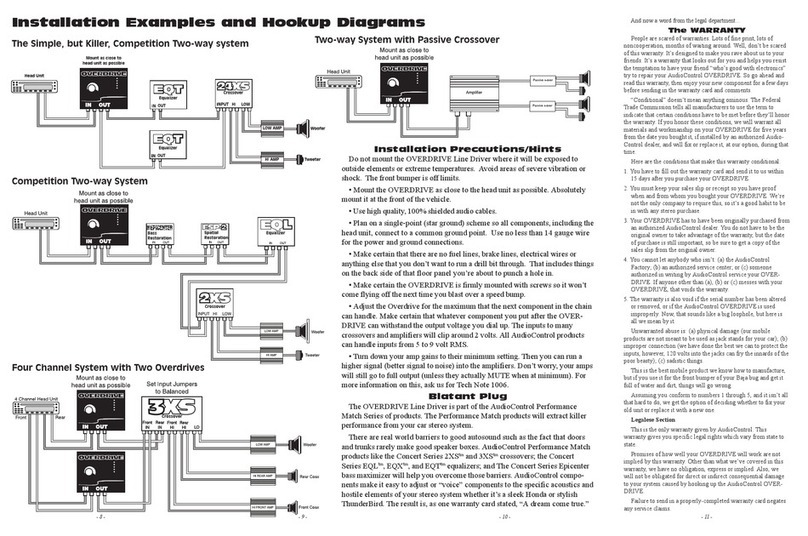
Audio Control
Audio Control OVERDRIVE User manual
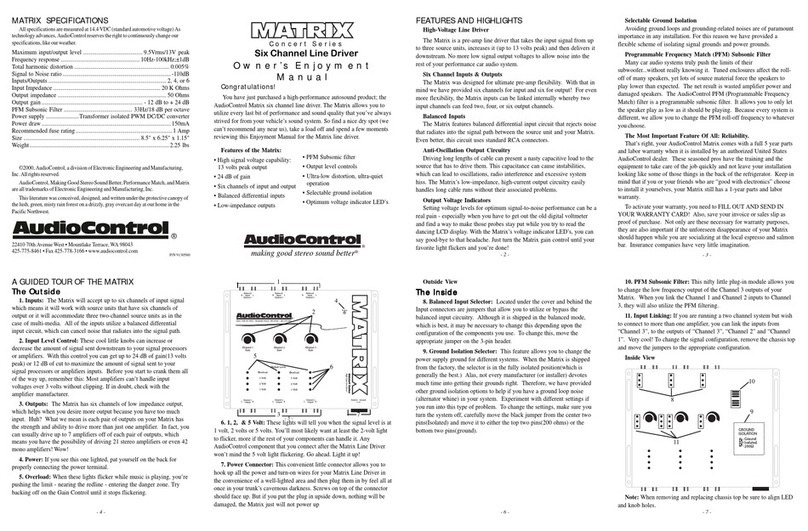
Audio Control
Audio Control MATRIX User manual
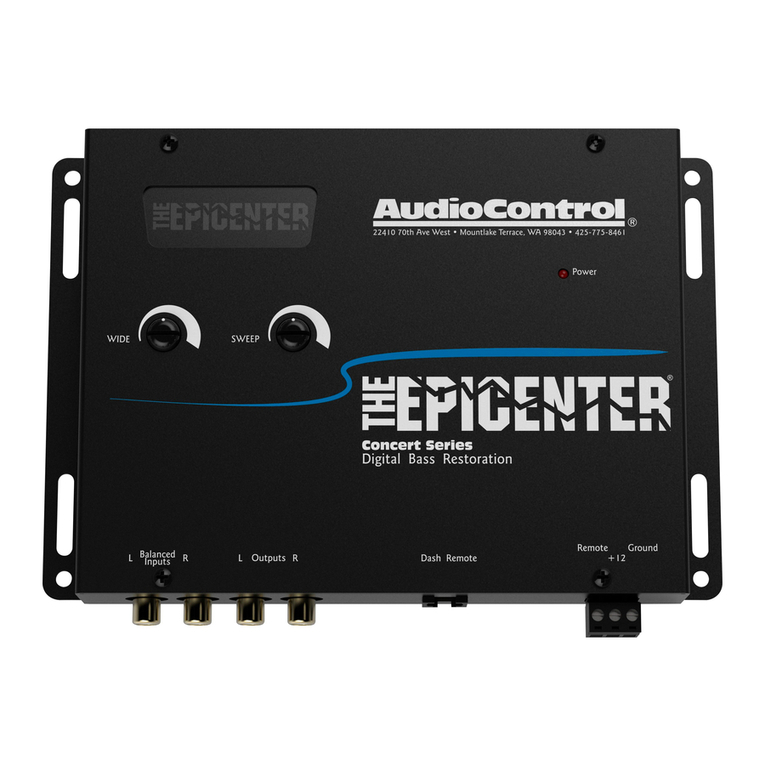
Audio Control
Audio Control EPICENTER User manual
